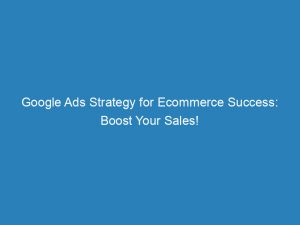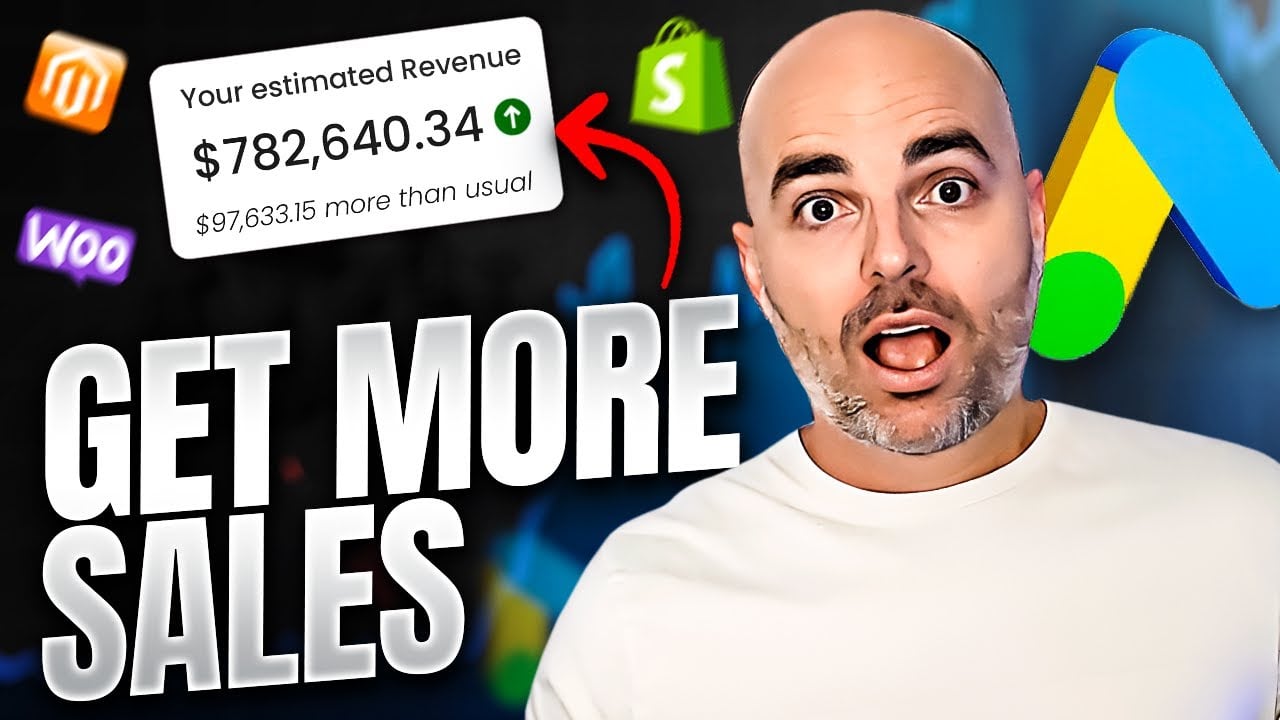- google ads strategy for ecommerce
- 1. Budget And Store Prerequisites
- 2. Recommended Budget: $1,000 Per Month
- 3. Store Prerequisites: Product Knowledge, Sensible Unit Economics, And Solid Infrastructure
- 4. Recommended Order Of Campaigns: Shopping Ads, Remarketing Ads, Search Ads, YouTube Ads, Display Ads
- 5. Campaign Types: Beginner, Intermediate, And Expert Levels
- 6. Setting Up Google Ads Account And Navigating The Platform
- 7. Importance Of Staying Updated And Using Tools Like Google Ads Editor And Analytics
- 8. Google Shopping Campaigns: Smart Shopping Vs.
In the vast landscape of online retail, one thing remains clear: Google Ads is the key to successforecommerce businesses. With its immense reach and powerful targeting capabilities, GoogleAds has revolutionized the way companies promote and sell their products.
However, mastering this platform is no easy feat. It requires careful planning, a dedicated budget, and a solid understanding of the platform’s nuances.
In this article, we’ll explore the essential strategies, recommended campaigns, and indispensable tools that will help you navigate the world of GoogleAds and achieve stellar results for your ecommerce store. Get ready to unlock the potential of this game-changing advertising platform.
| Item | Details |
|---|---|
| Topic | Google Ads Strategy for Ecommerce Success: Boost Your Sales! |
| Category | Ads |
| Key takeaway | In the vast landscape of online retail, one thing remains clear: Google Ads is the key to success for ecommerce businesses. |
| Last updated | December 28, 2025 |
ads-strategy-for-ecommerce">google ads strategy for ecommerce
The Google Ads strategy for ecommerce businesses is crucial in driving growth and attracting customers. Before delving into Google Ads, it is important to consider two key factors: budget and store prerequisites.
A recommended budget of at least $1,000 per month ensures a sufficient amount for effective campaigns. Moreover, store prerequisites, including product knowledge, sensible unit economics, and a solid infrastructure, must be in place to maximize the benefits of Google Ads.
The recommended order for running campaigns in Google Ads starts with Shopping Ads, followed by Remarketing Ads, Search Ads, YouTube Ads, and Display Ads. These campaign types are divided into Beginner, Intermediate, and Expert levels to cater to different levels of proficiency.
Setting up a Google Ads account and navigating the platform is vital, and staying updated with tools like Google Ads Editor and Google Analytics is essential for success. For ecommerce businesses, setting up Google Shopping campaigns is pivotal, with the choice between Smart Shopping and standard campaigns depending on specific needs.
Negative keywords and bidding strategies play a crucial role in optimizing campaign performance. Well-structured campaigns, along with the use of ad extensions, contribute to better results.
Dynamic Search Ads, targeting options, and demographics allow for effective targeting and customization. Display Ads require a different mindset and have unique targeting options.
Finally, YouTube Ads necessitate considerations such as targeting options and bidding strategies. Testing different strategies to find what works best for specific objectives is key to achieving success with Google Ads in ecommerce.Key Points:
- Budget and store prerequisites are important factors to consider before implementing a Google Ads strategy for ecommerce businesses.
- Shopping Ads, Remarketing Ads, Search Ads, YouTube Ads, and Display Ads should be run in a recommended order, catering to different levels of proficiency.
- Setting up a Google Ads account and staying updated with tools like Google Ads Editor and Google Analytics is vital for success.
- Google Shopping campaigns, with the choice between Smart Shopping and standard campaigns, are pivotal for ecommerce businesses.
- Optimizing campaign performance can be done through negative keywords, bidding strategies, well-structured campaigns, and ad extensions.
- Dynamic Search Ads, targeting options, demographics, and unique targeting options for Display Ads and YouTube Ads should be considered for effective customization and targeting.
Sources
https://www.storegrowers.com/google-ads-ecommerce/
https://www.goinflow.com/blog/google-ads-ecommerce-strategies/
https://www.omniconvert.com/blog/google-ads-ecommerce/
https://blog.storeya.com/2019/09/google-ads-for-ecommerce/
Check this out:
💡 Pro Tips:
1. Use Google Ads Editor and Google Analytics to stay updated and optimize your campaigns.
2. Consider using negative keywords and different bidding strategies to improve the performance of your ads.
3. Create well-structured campaigns and make use of ad extensions to enhance the effectiveness of your ads.
4. Experiment with dynamic search ads, targeting options, and demographics to find successful strategies for your campaigns.
5. Approach display ads with a different mindset and explore the various targeting options available to reach your desired audience.
1. Budget And Store Prerequisites
Before diving into Google Ads for your ecommerce business, it is crucial to consider two important factors – your budget and store prerequisites. These factors play a significant role in determining the success of your Google Ads strategy.
Budget: Allocating a sufficient budget is essential to achieve optimal results with Google Ads. While there is no one-size-fits-all approach, it is generally recommended to have a minimum budget of $1,000 per month.
This allows for effective targeting and testing of different strategies.
Store Prerequisites: Alongside budget considerations, you must ensure that your store meets certain prerequisites. Having a solid understanding of your products and industry is crucial.
Without sufficient product knowledge, it becomes challenging to create compelling ads and target the right audience. Additionally, sensible unit economics, such as knowing your profit margins and customer acquisition costs, will guide your bidding strategies effectively.
Lastly, a solid infrastructure, including a user-friendly website and seamless checkout process, is vital for a successful Google Ads campaign.
2. Recommended Budget: $1,000 Per Month
To maximize the potential of your Google Ads campaigns, it is recommended to have a budget of at least $1,000 per month. This budget allows you to allocate sufficient funds for each campaign, test different strategies, and optimize your ads for better performance.
While it is possible to start with a lower budget, increasing it over time can significantly amplify your results.
3. Store Prerequisites: Product Knowledge, Sensible Unit Economics, And Solid Infrastructure
To set yourself up for success with Google Ads, it is essential to ensure your store meets specific prerequisites. Here are the three critical aspects you need to consider:
Product Knowledge: It is crucial to have a solid understanding of your products and your target audience. By knowing your products inside out, you can create more compelling ads that resonate with your potential customers.
Understanding the pain points, desires, and preferences of your target market will help you craft persuasive and relevant ad copy.
Sensible Unit Economics: To make informed bidding decisions, you need to have sensible unit economics. This includes knowing your profit margins, customer acquisition costs, and lifetime value of a customer.
By working with these numbers, you can set realistic bidding strategies that align with your business goals and ensure profitability.
Solid Infrastructure: A user-friendly website and a seamless checkout process are essential for a successful Google Ads campaign. Your website should be optimized for mobile devices and have fast loading times.
A well-designed, easy-to-navigate website will enhance the user experience and increase the likelihood of conversions.
4. Recommended Order Of Campaigns: Shopping Ads, Remarketing Ads, Search Ads, YouTube Ads, Display Ads
To get the most out of your Google Ads strategy, it is recommended to follow a specific order when running different campaigns. This order takes into consideration the different campaign types and their impact on the customer journey.
The recommended order of campaigns is as follows:
Search Ads capture users at the moment of intent and direct them to specific landing pages.
These ads have a broader reach and are especially effective for brand awareness and reaching new audiences.
The order of campaigns allows for a sequential approach, building upon the previous campaigns’ success and targeting users throughout their journey from research to conversion.
5. Campaign Types: Beginner, Intermediate, And Expert Levels
To effectively manage and optimize your Google Ads strategy, it is crucial to understand the different campaign types and group them into appropriate levels based on complexity and expertise. Here’s how these campaign types can be categorized:
Beginner Level: At the beginner level, start with simple campaigns such as Google Shopping Ads and Search Ads. These campaigns require basic knowledge of the platform and allow you to understand the fundamentals of optimizing ad performance.
Intermediate Level: Once you have a grasp on the basics, move to intermediate-level campaigns such as Remarketing Ads. These campaigns require a deeper understanding of audience segmentation and targeting strategies to capture potential customers who have shown interest in your products.
Expert Level: At the expert level, explore more advanced campaign types like YouTube Ads and Display Ads. These campaigns demand a higher level of expertise and creativity to leverage the full potential of the respective ad formats and targeting options.
By categorizing your campaigns based on skill levels, you can progressively improve your Google Ads strategy and allocate resources appropriately.
6. Setting Up Google Ads Account And Navigating The Platform
Setting up a Google Ads account and navigating the platform is the foundation of your Google Ads strategy. Here are the steps to get started:
Navigating the platform may initially seem overwhelming, but Google Ads provides comprehensive resources and support to help you navigate and optimize your campaigns effectively.
7. Importance Of Staying Updated And Using Tools Like Google Ads Editor And Analytics
As with any digital marketing channel, staying updated with the latest trends and utilizing available tools is critical for success. Here are two essential tools that can enhance your Google Ads strategy:
Google Ads Editor: Google Ads Editor is a powerful desktop application that allows you to make bulk changes and optimizations to your Google Ads campaigns. It enables you to manage multiple accounts, copy and paste campaigns, and make offline edits.
By leveraging this tool, you can save time and streamline your campaign management process.
Google Analytics: Integrating Google Ads with Google Analytics provides valuable insights into user behavior and the effectiveness of your ads. It allows you to track conversions, analyze user engagement on your website, and implement advanced targeting strategies based on audience insights.
By staying updated with the latest features and using tools like Google Ads Editor and Google Analytics, you can refine your campaigns, optimize performance, and ultimately boost your ecommerce sales.
8. Google Shopping Campaigns: Smart Shopping Vs.
Standard
Google Shopping campaigns are highly effective for ecommerce businesses as they display visual product ads directly in the search results. When setting up Google Shopping campaigns, you have two options: Smart Shopping and standard campaigns.
Smart Shopping: Smart Shopping campaigns leverage machine learning to automatically optimize and display your ads across multiple Google networks, including Google Search, YouTube, Gmail, and the Google Display Network. By using a combination of your product feed and assets, Smart Shopping campaigns dynamically create and display ads to relevant audiences.
This automated approach simplifies campaign management but can limit control over bidding and targeting.
Standard Shopping: Standard Shopping campaigns provide more control over bidding, targeting, and campaign structure. With standard campaigns, you manually create ad groups and set individual bids for different products, allowing for greater customization and optimization.
This option suits businesses that prefer a more hands-on approach and want to refine their targeting strategies.
Choosing between Smart Shopping and standard campaigns depends on your business objectives, available resources, and level of expertise. Testing both options and analyzing the results will help you determine which approach yields the best results for your ecommerce business.
This post updated with new ad network performance data.
In conclusion, Google Ads is a powerful marketing channel for ecommerce businesses. By carefully considering your budget, meeting store prerequisites, following the recommended order of campaigns, understanding different campaign types, and utilizing essential tools, you can build an effective and successful Google Ads strategy to boost your ecommerce sales.
Remember to continually test and optimize your strategies to stay ahead of the competition and achieve long-term success.
Advertising Platform for Marketers • Buy Traffic • Performance Marketing Tips • Self-Serve DSP Platform • Programmatic Advertising











